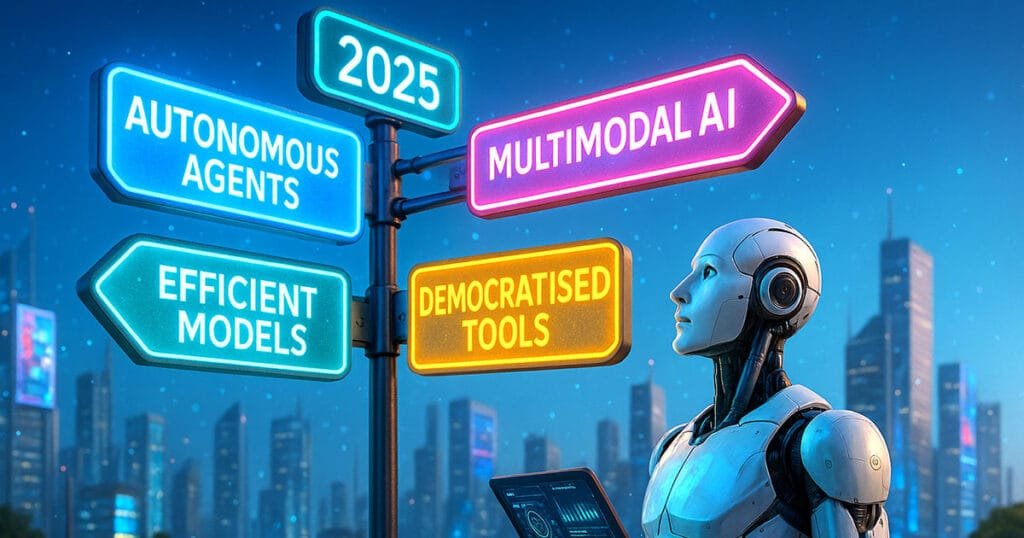TL;DR
- AI software development differs from traditional coding by using data-driven, probabilistic models rather than rule-based logic.
- The global AI software market reached £174.1 billion in 2025 and is growing at 25% annually.
- Businesses achieve 30-50% efficiency gains through AI automation, with 78% of organisations now adopting AI tools.
- Success requires hybrid strategies: use off-the-shelf solutions for standard tasks, build custom AI for competitive advantage.

What Is AI Software Development and How Does It Transform Business?
AI software development creates applications that learn from data to make predictions and decisions, fundamentally changing how software behaves and adapts.
AI software development represents a shift from traditional rule-based programming to systems that learn patterns from data. Unlike conventional software that follows explicit instructions, AI applications use machine learning algorithms to adapt their behaviour based on the information they process.
Traditional software operates deterministically. Input A always produces Output B. AI software operates probabilistically. It makes educated predictions with varying degrees of confidence, enabling it to handle complex tasks like image recognition, natural language processing, and predictive analytics.
This fundamental difference opens up entirely new possibilities. AI can recognise patterns humans might miss, process vast amounts of unstructured data, and continuously improve its performance through exposure to new information.
The global AI software market reached $174.1 billion in 2025 and is growing at 25% annually, demonstrating the technology’s rapid business adoption across industries.
The business impact is already measurable. Companies using AI report significant improvements in efficiency, accuracy, and customer satisfaction, with many achieving competitive advantages through personalised services and automated decision-making.

How Does AI Software Development Work?
AI development follows a data-centric, iterative process that differs significantly from traditional software engineering approaches.
The AI Development Lifecycle
AI projects begin with problem definition and business goal setting. Teams identify specific challenges AI can address, such as reducing customer service response times or improving fraud detection accuracy. Success metrics must tie directly to business outcomes rather than just technical performance.
Data collection and preparation consume 60-80% of project time. AI systems require high-quality, representative datasets to learn effectively. Data preparation involves gathering data from various sources, cleaning inconsistencies, handling missing values, and ensuring the dataset reflects real-world conditions without harmful biases.
Model development involves selecting appropriate algorithms and architectures. For image recognition tasks, teams might use Convolutional Neural Networks. For text analysis, Transformer models like those powering ChatGPT prove effective. The choice depends on the problem, available data, and performance requirements.
Training and evaluation test the model’s performance using separate datasets. Unlike traditional software testing for binary pass/fail conditions, AI evaluation measures probabilistic accuracy, precision, and recall. Models must generalise well to new, unseen data rather than simply memorising training examples.
Modern AI Platforms and Tools
Leading cloud platforms like Google Vertex AI, Microsoft Azure AI, and AWS SageMaker provide end-to-end AI development environments. These platforms integrate data storage, model training, and deployment tools within unified interfaces.
Google Vertex AI offers AutoML for no-code model training and Custom Training for complete control. Microsoft Azure AI provides access to OpenAI models like GPT-4 with enterprise security. AWS SageMaker includes visual, no-code interfaces for business analysts alongside powerful tools for data scientists.
In 2025, generative AI usage among business leaders jumped from 55% to 75%, driven by increasingly accessible platforms and proven business value.
The democratisation of AI development continues through low-code platforms and pre-trained models. Businesses can now build sophisticated AI applications without deep technical expertise, accelerating adoption across industries.

What Business Results Can You Expect from AI Software?
Real-world AI implementations deliver measurable improvements in efficiency, cost reduction, and customer experience across multiple industries.
Healthcare Transformations
AI is revolutionising medical diagnostics and operations. In the UK, AI-assisted chest X-ray analysis improved diagnostic accuracy by 45% and reduced lung cancer treatment delays by nine days. Spanish hospitals using AI mammography screening reduced false negatives by 28%.
Healthcare AI also streamlines administrative tasks. A UK surgery implemented AI call handling that now answers 100% of calls within three rings and resolves 82% autonomously, saving 15 work days weekly. These efficiency gains allow medical staff to focus on patient care rather than routine administration.
Financial Services Innovation
AI adoption in financial services could unlock £12.7 billion in annual cost savings for UK banking alone. Real implementations show dramatic improvements: one institution reduced customer complaint processing time by 30-50% using AI case management, while another achieved 90% faster Know Your Customer processing.
Revenue generation proves equally impressive. Banks using AI for personalised recommendations and risk assessment report significant increases in customer engagement and loan approval accuracy, directly impacting profitability.
Customer Service Revolution
AI transforms customer interactions from reactive support to proactive assistance. Vodafone’s AI chatbot handles 1 million monthly interactions with 70% first-time resolution rates. Energy supplier Octopus Energy achieved 80% customer satisfaction with AI-handled emails, surpassing human agent performance at 65%.
These improvements extend beyond efficiency. AI enables 24/7 availability, consistent service quality, and the ability to handle multiple languages and complex queries simultaneously.
Manufacturing and Operations
AI optimises production processes, supply chains, and maintenance schedules. Predictive maintenance systems reduce unplanned downtime by identifying equipment issues before failures occur. Quality control AI detects defects with superhuman accuracy and speed.
Smart factories use AI to optimise resource allocation, reduce waste, and improve safety through real-time monitoring and automated responses to changing conditions.

What Are the Key Trends Shaping AI Development in 2025?
Four major trends are transforming AI software development: autonomous agents, multimodal capabilities, efficiency-focused models, and democratised development tools.
Autonomous AI Agents
Agentic AI represents the shift from AI as a passive tool to active, autonomous systems that can plan and execute complex tasks. These systems understand high-level goals, create execution plans, and autonomously complete multi-step workflows using various tools.
37% of IT leaders believe they already have agentic AI capabilities, with 68% expecting implementation within six months. Early applications focus on structured internal tasks like password management and vacation booking, gradually expanding to customer-facing interactions.
Multimodal AI Systems
Modern AI processes multiple data types simultaneously, including text, images, audio, and video, for richer understanding. For example, a healthcare AI might analyse patient records (text), medical scans (images), and voice recordings (audio) to provide comprehensive diagnostic suggestions.
This capability enables more natural human-AI interaction. Users can upload photos while asking questions verbally, and AI responds appropriately using all available context.
Small Language Models (SLMs)
Small Language Models (Slms) with less than one billion parameters offer cost-effective alternatives to massive systems. They provide faster responses, lower costs, and the ability to run on edge devices like smartphones without internet connectivity.
Microsoft’s Phi-3 and Meta’s Llama 4 demonstrate that smaller, focused models can match larger systems’ performance for specific tasks while requiring significantly fewer computational resources.
Low-Code AI Development
Platforms now enable business users to build AI applications using visual interfaces and natural language descriptions. This democratisation unleashes innovation by empowering non-technical teams to create AI solutions for their specific challenges.
The convergence of these trends creates “Compound AI” systems, autonomous agents running efficient models with multimodal understanding developed using accessible tools. This combination exponentially expands AI’s application possibilities.

How Much Does AI Software Development Cost, and What’s the ROI?
AI project costs range from £8,000 for simple proofs-of-concept to over £400,000 for enterprise systems, with careful planning essential for positive returns.
Cost Breakdown by Project Phase
Discovery and planning typically consume 5-15% of budgets, covering problem definition, data assessment, and project road mapping. Data preparation and feature engineering often represent the most significant expense at 15-30%, involving collection, cleaning, labelling, and annotation activities.
Model development and training require 20-40% of resources, driven by algorithm complexity and computational requirements. Training advanced models can cost millions in hardware usage alone. Integration, deployment, testing, and quality assurance complete the initial investment.
Ongoing Operational Costs
AI systems require continuous maintenance, monitoring, and retraining to combat model drift and maintain performance. Monthly operational costs range from £400 to over £8,000, depending on scale, usage patterns, and infrastructure requirements.
These ongoing expenses often surprise organisations. Unlike traditional software that remains stable after deployment, AI systems need regular updates as real-world data patterns change.
Build vs Buy Decisions
Off-the-shelf solutions suit standard business functions with lower initial costs and immediate implementation. Custom development provides competitive advantages and perfect workflow alignment, but requires significant investment and longer timelines.
72% of Fortune 500 companies adopt hybrid strategies, using off-the-shelf tools for standard tasks while investing custom development resources in core competitive functions. This approach balances quick wins with long-term strategic advantages.
ROI Measurement and Expectations
Organisations report productivity boosts up to 100x in some AI applications, though realistic expectations should focus on 20-50% efficiency improvements for most implementations. Success measurement should examine specific outcomes rather than broad organisational impact.
Leading companies quantify ROI by measuring AI’s impact on discrete tasks like test generation, documentation, or language translation. This granular approach provides a more apparent justification for continued investment and identifies the most valuable AI applications.




